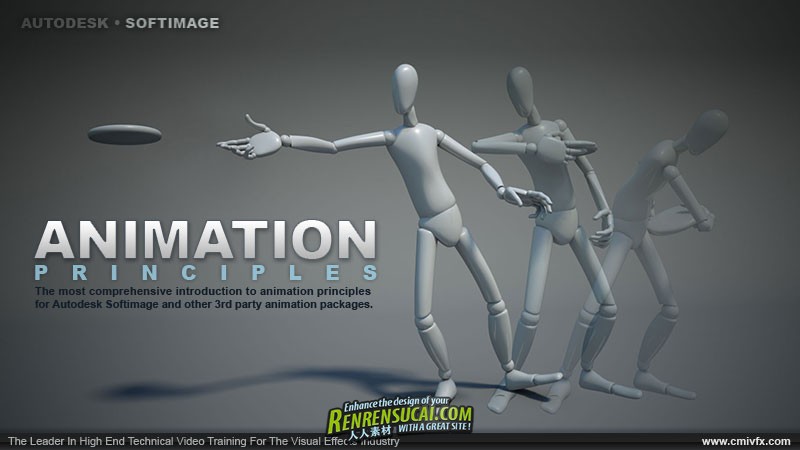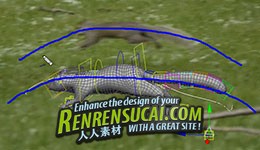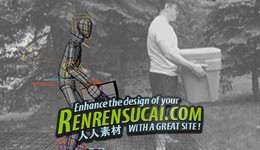| 中文名称: | Softimage视觉动画特效高级教程 |
|---|---|
| 外文名称: | cmiVFX Softimage Animation Principles |
| 资源分类: | 教程 视觉动画 特效 Softimage cmiVFX |
| 文件大小: | 2.1 |
| 资源格式: | mp4 |

本教程是由cmiVFX机构出品的Softimage视觉动画特效高级教程。
SOFTIMAGE公司是加拿大Avid公司旗下的子公司。SOFTIMAGE 3D是专业动画设计师的重要工具。用SOFTIMAGE 3D创建和制作的作品占据了娱乐业和影视业的主要市场,《泰坦尼克号》、《失落的世界》、《第五元素》等电影中的很多镜头都是由SOFTIMAGES 3D制作完成的,创造了惊人的视觉效果。
SOFTIMAGE XSI是AUTO DESK(AVID公司已经被AUTO DESK公司收购!)面向高端三维影视市场的旗舰产品,以其独一无二真正的非线性动画编辑为众多从事三维电脑艺术人员所喜爱。XSI将电脑的三维动画虚拟能力推向了极致。是最佳的动画工具,除了新的非线性动画功能之外,比之前更容易设定Keyframe的传统动画。是制作电影,广告,3D,建筑表现等方面的强力工具。
cmiVFX Softimage Animation Principles
This video is geared to train everyone and anyone in the Computer Graphics and Visual Effects industries. The principles of animation are static rules that have worked since the beginning of the invention of movement itself. If your an artist that even questions if they know these principles completely, then this video is for you, even if you do not use Softimage as your tool of choice. This video is extremely agnostic to any particular features, but makes great use of the tools Softimage has become famous for.
Strong Poses
From superhero poses to subtle elegant moments frozen in time, understanding the human form in space is one of the cornerstones of animation. With a special thanks to the explorations by Keith Lango, we explore these poses using some very powerful rigging systems in Softimage. The user will see how easy it is to examine the subtle and powerful aspects of the human form, and compose it in dimensional space.
Timing
Strong poses with great timing makes up 90 percent of great animation. We will be using the technique of pose-to-pose animation while getting familiar with the Animation Editor and Dope Sheet. Follow along as we set our poses, then move the keys to adjust the timing, blocking out the action quickly and efficiently.
Anticipation
Here's the windup, and there's the pitch! We'll talk about the windup, or anticipation in this chapter. Before the action can start, there is a moment of preparation. This serves to create a realistic feeling of power, and as a storytelling device, as it prepare the audience for the action itself.
Arcs
We will begin working in layers, tweaking and refining the motion we have created, using Softimage's "plot to curve" tool to analyze motion paths through space. We will make sure the arcs are strong and natural, and that they show the proper speed and acceleration.
Squash and Stretch
We will use the "bouncing ball" scene, a favorite of almost every animator working in the industry, to explore squash and stretch. We will also integrate this concept into the human body using some of the powerful rigs available in Softimage.
Line of Action
As we move deeper into some of the more subtle tweaks, we can use the principles of Strong Poses and Arcs, and begin to study "Line of Action". Professional animators talk about "animating the action, not the object". Line of action allows us to practice this principle, and we can practice using a squirrel, whose very movement illustrates this principle nicely.
Ease-In Ease-Out
We will look more deeply into the Animation Editor, and use it to illustrate the concept of acceleration and deceleration, or "Ease-In and Ease-Out", the interpolation of motion between the keys.
Breaking Joints
The keys we create in pose-to-pose animation seem very mechanical and robotic without some much needed attention. We will offset some of the motion keys to add some naturalism. Human motion and movement in nature follow a flow, delaying a little bit from the center of the body through the limbs, or the tip of the tail.
Mass and Scale
No discussion about animation would be complete without talking about mass and scale. We will use our principles of timing and poses to create the illusion of light and heavy, youth and age, and gender differences. We will also go through some techniques to show how to lift heavy and light objects and the differences it has on the body.
Secondary Motion - Overshoot
The final principle is generally handled at the end of the animation process, but is no less important. Overshoot and Secondary Motion is the principle that nothing in nature comes to a dead stop. There is almost always a slight "bounce". at the end of a motion. We will also cover some of the amazing ICE Syflex tools in Softimage to simulate cloth.
Christopher Tedin
Born in Sitka, Alaska, Chris started his career as a painter and sculptor. He has been working as an illustrator, graphic designer, and most recently as an art director in Chicago, Illinois. He has been teaching game design and animation for over 15 years. His students now work as animators and professional game designers at Blue Sky Studios, Digital Domain, Aardman/Sony, Microsoft, and as freelance independent artists. Many of his students are now college teachers themselves. He started in the early days with Strata StudioPro, then 3ds Max version 1.0, Maya 2.0, Softimage 3.8, Houdini, before finally settling on Softimage XSI, beginning with version 4.0 Foundation. Chris still sculpts and paints and teaches part time at Tribeca/Flashpoint Academy in Chicago.
Project Contents
All cmiVFX videos come with all the training materials you can need right from our website. No matter what time of day, your location, or how your feeling, cmiVFX will be there waiting for you!





http://www.rr-sc.com/thread-46663-1-1.html
如有问题,请联系邮箱:rrscteam@qq.com
